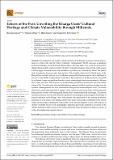Por favor, use este identificador para citar o enlazar a este item:
http://hdl.handle.net/10261/344493COMPARTIR / EXPORTAR:
 SHARE SHARE
 CORE
BASE CORE
BASE
|
|
| Visualizar otros formatos: MARC | Dublin Core | RDF | ORE | MODS | METS | DIDL | DATACITE | |

| Título: | Echoes of the Past: Unveiling the Kharga Oasis’ Cultural Heritage and Climate Vulnerability through Millennia |
Autor: | Ismael, Hossam; Abbas, Waleed; Ghaly, Heba; El Kenawy, Ahmed M. CSIC ORCID | Palabras clave: | Paleoclimate change Vulnerability ITCZ Civilized heritage |
Fecha de publicación: | sep-2023 | Editor: | Multidisciplinary Digital Publishing Institute | Citación: | Heritage 6(9): 6397-6421 (2023) | Resumen: | The civilization and tangible cultural heritage of the Kharga Oasis has a historical precedence over that of the old Nile Valley civilization. Approximately 12,000 years ago, a significant prehistoric migration occurred from the Kharga Oasis to the Nile Valley. This event was motivated by climate change and the southward shift of the Inter-Tropical Convergence Zone (ITCZ), which caused a shift in Egypt’s savannah forests from abundant vegetation to an extremely dry desert. The present study investigates the progressive deterioration of the tangible cultural and civilized legacy of the Kharga Oasis over the course of several millennia, positing that this phenomenon can be attributed to the area’s vulnerability to paleoclimatic fluctuations. The evaluation of the Kharga Oasis’ susceptibility to climate change was predicated on the scrutiny of petroglyphs that were unearthed at different sites within the Oasis. This analysis was reinforced by paleoclimate information and radiocarbon dating (C14). The utilization of an interdisciplinary approach yielded significant insights into the dynamic climate patterns and their effects on the Kharga Oasis across temporal scales. The results illustrated a noteworthy alteration in climate, which caused the conversion of the Oasis terrain from being heavily wooded to becoming arid, mainly due to extended periods of drought. The present research postulates a novel and alternate hypothesis concerning the archaeological chronology of human habitation in the Kharga Oasis from ancient eras, predicated on the analysis of pictorial depictions on rock surfaces. The findings of this study made a noteworthy contribution to the current corpus of knowledge regarding the vulnerability of the ancient Egyptian society to the impacts of climate variability. Moreover, the petroglyphs’ depictions provided a distinctive viewpoint on the climatic fluctuations that occurred in the Sahara and North Africa throughout the Holocene epoch, as well as the fundamental causative factors. | Versión del editor: | https://doi.org/10.3390/heritage6090335 | URI: | http://hdl.handle.net/10261/344493 | DOI: | 10.3390/heritage6090335 | E-ISSN: | 2571-9408 |
| Aparece en las colecciones: | (IPE) Artículos |
Ficheros en este ítem:
| Fichero | Descripción | Tamaño | Formato | |
|---|---|---|---|---|
| Echoes_heritage_2023_OA.pdf | 21,48 MB | Adobe PDF |  Visualizar/Abrir |
CORE Recommender
SCOPUSTM
Citations
1
checked on 07-may-2024
Page view(s)
9
checked on 15-may-2024
Download(s)
2
checked on 15-may-2024
Google ScholarTM
Check
Altmetric
Altmetric
Este item está licenciado bajo una Licencia Creative Commons

